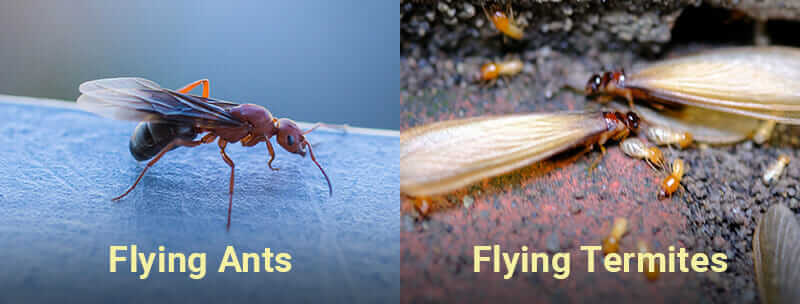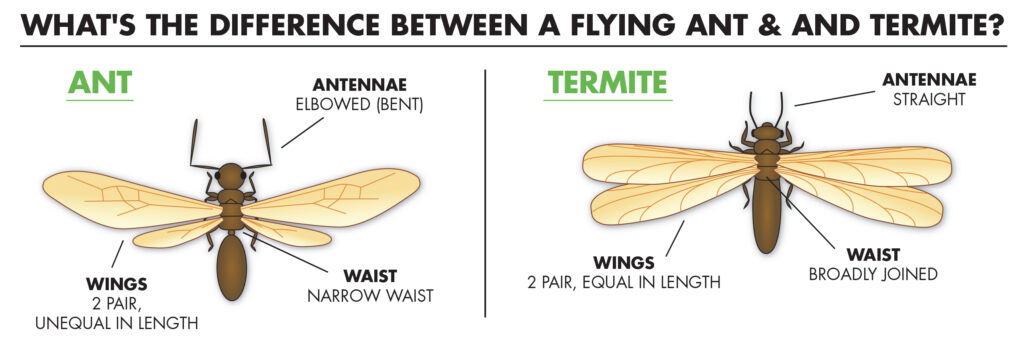Do you see tiny flying insects near your home? Are you unsure whether they’re flying ants or termites? Understanding the differences between these two insects is important to protect your home and prevent potential damage. Flying ants and termites look similar, but they are very different when it comes to appearance, behavior, diet, and life cycles. Let’s break it down so you can identify them and take action.
Appearance Differences of Flying Ants vs Termites
The easiest way to tell the difference between a flying ant vs termite is by looking closely at their bodies, wings, and antennae. Though they both have wings, their body shapes and structures are distinct.
Flying Ants
- Body shape: Flying ants have a narrow, pinched waist.
- Antennae: Their antennae are elbowed or bent.
- Wings: Flying ants have two sets of wings, with the front wings longer than the hind wings.
- Color: They are usually reddish-brown or black.
Termites
- Body shape: Termites have a straight, uniform waist.
- Antennae: Their antennae are straight, not bent.
- Wings: Termites have two sets of wings that are equal in size and shape.
- Color: They are generally dark brown or black.
Termites vs Flying Ants: Behavior Differences

Understanding the behavior of termites vs flying ants can help you identify them.
Flying Ants
- Swarming season: Flying ants usually swarm during the summer to find mates and start new colonies.
- Habitat: They don’t eat wood but can nest in small cracks, plants, or moist areas.
- Attraction to light: Flying ants are often seen around lights at night.
Termites
- Swarming season: Termites typically swarm in the spring, especially after heavy rainfall.
- Habitat: Termites prefer dark, damp areas and live in soil, wood, or decaying plant matter.
- Damage: Termites eat wood and can cause serious harm to your home’s structure.
Life Cycle Differences

Both flying ants and termites go through developmental stages, but there are key differences in how they grow.
Flying Ants
- Stages: Flying ants experience four stages—egg, larva, pupa, and adult.
- Lifespan: Worker ants live a few months, but queen ants may live for several years.
- Colony growth: Males die after mating, while queens create new colonies.
Termites
- Stages: Termites go through three stages—egg, nymph (larvae), and adult.
- Lifespan: Worker termites survive a couple of years, but queen termites can live for decades.
- Colony growth: Both males and females continue to live and grow their colony after mating.
Diet Differences
What these insects eat shows another big difference.
- Flying ants are omnivores. They eat nectar, seeds, other insects, and food scraps.
- Termites, on the other hand, mainly eat cellulose. This is found in wood, paper, and cardboard, making them a threat to your home.
Read Our Most Recently Published Guides on Termites, Earwigs, Fruit Flies and Gnats:
- What Do Bed Bugs Look Like?
- Early Signs of Bed Bugs on Mattress? Explained in 2025
- Skin Early Signs of Bed Bugs? Identification, Prevention
- Tiny Baby Termites? Everything You Need to Know in 2025
- What Do Baby Termites Look Like? Termite Identification and Treatment in 2025
- Baby Termites vs Ants? How to Tell the Difference
- Fruit Flies vs Gnats: How to Tell the Difference in 2025
- Fungus Gnats vs Fruit Flies: How to Tell the Difference in 2025
- Are Earwigs Dangerous or Poisonous to Humans and Dogs?
- Why Are There Earwigs in My House? Prevention and Treatment Guide
Quick Comparison Table
| Feature | Flying Ants | Termites |
| Waist | Narrow, pinched | Straight |
| Antennae | Elbowed or bent | Straight |
| Wings | Front wings larger than hind wings | Both pairs equal in size and shape |
| Color | Reddish-brown or black | Dark brown or black |
| Diet | Nectar, seeds, insects, food scraps | Cellulose (wood, paper, etc.) |
| Season to swarm | Summer | Spring |
| Lifespan of queen | Several years | Can live for decades |
How to Identify Flying Ants or Termites in Your Home
If you spot swarming insects, here’s what to do:
- Look at their body and wings using the differences above.
- Check for wing piles; termites often leave discarded wings near windows, doors, or light sources.
- Inspect for damage. If you find hollowed-out wood or mud tubes, it’s likely termites.
Taking action quickly can help avoid bigger problems. Follow Us on Facebook, Pinterest and Twitter for the latest updates.
FAQs
How do I get rid of flying ants or termites?
For flying ants, use simple spray repellents or seal cracks to prevent entry. For termites, call a professional to treat the infestation and protect your home from damage.
Why do flying ants suddenly appear?
Flying ants usually appear in warm weather, specifically during their mating season. They leave their colonies to find mates and form new nests.
Can flying ants damage your home?
Flying ants don’t eat wood like termites, so they rarely cause structural damage. However, certain types like carpenter ants can weaken wooden structures by creating nests.
Does a flying ant look like a termite?
At first glance, they might look similar because both have wings and swarm, but their body shape, antennae, and wings are different.
How do I know if I have termites or flying ants?
Check their appearance. Flying ants have bent antennae and a skinny waist, while termites have straight antennae and no pinched waist.
What attracts flying ants to a home?
Flying ants are attracted to light, sugary foods, open cracks in walls, and moisture.
Will flying ants eventually go away?
Flying ants often disappear after their mating season ends. However, if you notice them frequently, they may have nested nearby.
Why do flying termites suddenly appear?
Flying termites swarm when they’re ready to mate and start a new colony. Swarms often happen after rain.
Are there bugs that look like flying termites?
Yes, flying ants look similar to termites but have distinguishing features like elbowed antennae and a pinched waist.



